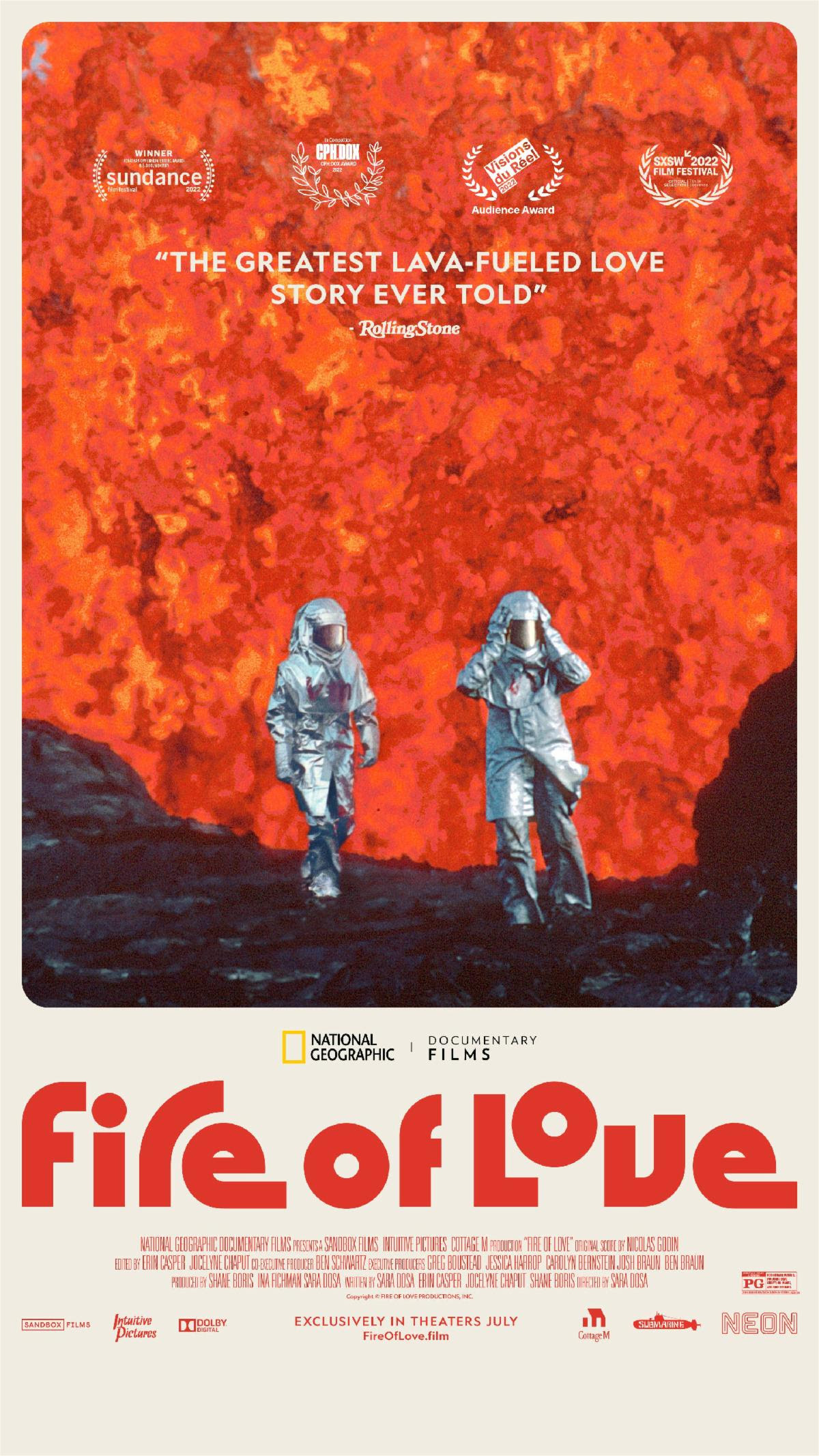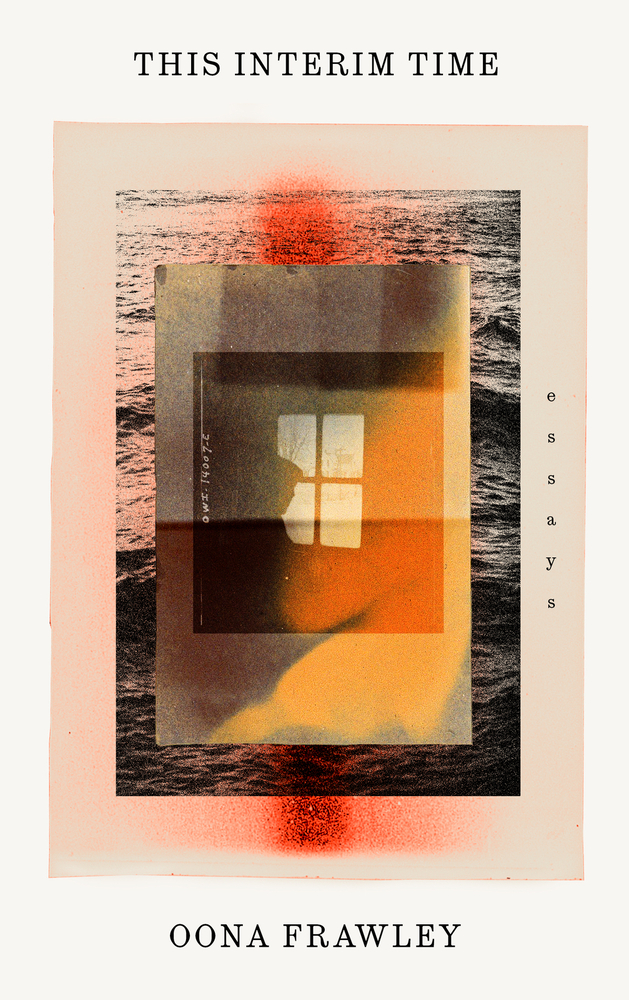Film by SARA DOSA
Review by HANNAH GERSEN

You don’t expect a documentary about volcanos to begin in freezing temperatures, but in the first scenes of Sara Dosa’s enthralling new feature, Fire of Love, married volcanologists Katia and Maurice Krafft struggle to free a jeep mired in icy slush. Farther down the road is a fiery pool of molten lava. Much later in the film, they trudge through the gray ash of a recently erupted Mount St. Helens, a setting that looks cold even though it is baking hot. Both landscapes seem unreal, even with Maurice and Katia in the frame. Their footage is so remarkable that I would have watched a 90-minute slide show of their photographs. Fire of Love is much more than that, but the film and photo archive is at the heart of the story, and it’s where Dosa looks for clues as she tells the story of the Kraffts’ career, one that was inseparable from their romantic partnership.
Dosa uses lyrical narration, voiced by Miranda July, to describe how a shared obsession for volcanos fueled the Kraffts’ personal and professional lives. Dosa begins with the fact of their untimely death in 1991, when they were killed while observing Japan’s Mount Unzen, then jumps back to their childhoods, when they first became transfixed by volcanos. From there, the film proceeds chronologically. July’s distinctively melancholy voice is well-suited to the searching quality of the narration, which acknowledges the many gaps in understanding—both of volcanos and of the Kraffts’ marriage. Although they often appeared together on television, and were frequently interviewed about their work, very little is known about their early life, including how they met and fell in love. They both grew up in the Alsace region of France, but did not meet each other until adulthood. The circumstances of their first date and subsequent courtship are sketchy, with little photographic evidence, save one poignant snapshot of a very young and elfin Katia looking adoringly at Maurice. Dosa guesses that they fell for each other quickly, playfully illustrating their first encounter—rumored to be a blind date in a café—with a stylish animation of two coffee cups, shot from above. In another simple animation, she creates a collaged map of Alsace, one that shows the tectonic plates moving beneath the region and perhaps subtly altering the fate of the people above.
The theory of plate tectonics, which posits that Earth’s surface is made up of large, rocky plates, which shift as they settle on a layer of molten lava, was not widely accepted until the 1960s, when Katia and Maurice, who were born in 1940s, were in college. The behavior and personality of a volcano—I’m borrowing this anthropomorphic language from the Kraffts—is determined by the movement of the plates beneath it. There are “red” volcanos, which spew lava and occur when tectonic plates move apart. Lava flow behaves like water as it moves through valleys, and Katia and Maurice felt safe getting quite close to active eruptions of red volcanos. Gray volcanos are much less predictable, occurring when slow-moving colliding plates reach a pressure point that causes an explosion. They are extremely dangerous, mainly because the timing, power, and cause of their bomb-like effusions is hard to predict. Some of the world’s most well-known volcanic eruptions, like Mount Vesuvius and Mount Tambora, were “grays.” The Kraffts started their careers with red volcanos, but as they became more involved in efforts to prevent death and destruction caused by volcanos, they began to focus on the more unpredictable grays. Unzen, the volcano that killed them, was a gray.
The red volcanos, in addition to being friendlier, are a lot more photogenic than the gray ones. I was mesmerized by the footage of roiling lava that seemed to hold incandescent shades of red. The Kraffts captured incredible videos of lava flows, including films of lava tumbling into the sea and continuing to burn while sinking below the surface of the water. With underwater cameras, they observed lava erupting from the sea floor, a process that can signal the beginning of a new volcanic island. The lava gives the impression of being alive, or as if it is trying to communicate something from the center of the earth. I cannot overemphasize how fundamentally mind-bending it is to see the earth split open, spewing acres of rocks that move through the landscape with terrifying speed, upending your sense of time, and perhaps your perception of the ground itself. For me, it was not difficult to understand why the Kraffts felt compelled to chase active volcano sites. They reminded me of extreme athletes in their desire to experience life at a high pitch, and to go places and do things that ordinary people would find absurdly risky.
Fire of Love is a film that invites you to imagine the Kraffts’ motivations, because so much of their interpersonal dynamic is unknown. Dosa suggests that they were temperamentally quite different. Maurice was more of a risk-taker, though whether that is owing to masculine entitlement or personality is hard to say. Physically, he was a lot bigger than Katia; Dosa likens him to an elephant seal. I would compare him to John C. Reilly, the actor he most resembles, and with whom he shares a goofy charm. In television interviews, Maurice describes his fanciful wish to ride a canoe down a lava flow and into the ocean; he genuinely seems to believe in the possibility, arguing that he would be safe if the ride didn’t last too long. In one extended sequence, we see Maurice and a fellow researcher take a raft across a dangerously acidic lake. Katia was not happy about the excursion, which served no scientific purpose, and almost became fatal when an ill wind blew them out further than they anticipated. Whoever shot the film also captured footage of Katia pacing in the background. You can’t help wondering about the arguments the two of them must have had that night.
Katia’s personality is most clearly expressed through her photography, which Dosa frequently incorporates alongside video footage, which tended to be Maurice’s domain. Katia had a wonderful sense of composition, photographing the quotidian as well as the sublime, with pictures of the couple’s day-to-day realities: broken boots and burned skin, improvised meals and ramshackle vehicles. The Kraffts raised money for their expeditions with books and media appearances, and, over time, they honed public personas and learned to craft images toward a more dramatic narrative. The archive shows the Kraffts trying out different poses at the same location, and, in television interviews, they often recycle patter, playing up the unusual fact of their shared vocation. Their wardrobe is also camera-friendly, and they stick to a color palette of light blue, gray, white, and silver, with red hats and socks to accent their look. When I first saw the Kraffts in preview trailers, I thought they looked like Wes Anderson characters. (The documentary’s soundtrack is also Andersonian, a mixtape of pop songs plucked from different eras.) Like Anderson, the Kraffts were probably influenced by the style of the French New Wave, which emerged when they were teenagers. The images they created together often have the playful aesthetic of those films, and that, combined with their unusual love story, likely helped to make them stars in their field, though the documentary does not spend a lot of time contextualizing their research within the field of volcanology. Instead, Dosa focuses on their unique creative partnership.
One of the themes of Fire of Love is the idea that Maurice and Katia’s love of volcanoes strengthened, and maybe even created, their love for each other. But it also brought them to an early death when they were still in their forties, and it was unclear to me if they had the same tolerance for risk. Both knew and accepted the dangers of their work and clearly believed it was important to get as close to active volcanos as possible. But as they began to inch toward the date of their death, I found myself wondering if their mutual obsession pushed them to take greater risks than they would have on their own—or if either or both would have survived longer if they’d been romantically involved with someone with a more conventional attitude toward molten rivers of lava. I wasn’t totally convinced it was a good thing that Katia had married a man whose attitude toward death was sometimes cavalier. Then again, given the era that Katia grew up in, it’s hard to imagine any other man understanding her drive to visit the world’s most forbidding landscapes. Perhaps his support gave her access to more dangerous sites—and for all I know, she was the one venturing into riskier areas. Dosa doesn’t answer these questions in her narration, and I don’t mean to suggest that she should have. I liked the mystery at the heart of this documentary, the fact that so much of Katia and Maurice remains unknown, despite the hundreds of hours of footage, the thousands of photographs, and decades of scientific research. The one thing we know is that they left the world together, doing what they loved best.
Fire of Love is playing in theaters now and will be streaming on Disney+ this fall.
Hannah Gersen is the author of Home Field and a staff writer at The Millions. She writes about movies in her monthly newsletter, Thelma & Alice: https://thelmaandalice.substack.com.




